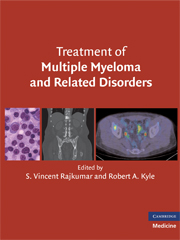Book contents
- Frontmatter
- Contents
- List of Contributors
- 1 DIAGNOSIS AND GENETIC CLASSIFICATION OF MULTIPLE MYELOMA
- 2 STAGING AND RISK-STRATIFICATION OF MULTIPLE MYELOMA
- 3 TREATMENT OF NEWLY DIAGNOSED MULTIPLE MYELOMA
- 4 MAINTENANCE THERAPY IN MULTIPLE MYELOMA
- 5 TREATMENT OF RELAPSED AND RELAPSED/REFRACTORY MULTIPLE MYELOMA
- 6 DIAGNOSIS AND TREATMENT OF MYELOMA BONE DISEASE
- 7 TREATMENT OF MYELOMA-RELATED COMPLICATIONS
- 8 AUTOLOGOUS TRANSPLANTATION FOR MULTIPLE MYELOMA
- 9 ALLOGENEIC STEM CELL TRANSPLANTATION FOR MULTIPLE MYELOMA
- 10 IMMUNOGLOBULIN LIGHT CHAIN AMYLOIDOSIS
- 11 WALDENSTRÖM MACROGLOBULINEMIA/LYMPHOPLASMACYTIC LYMPHOMA
- 12 DIAGNOSIS, RISK-STRATIFICATION, AND MANAGEMENT OF SOLITARY PLASMACYTOMA
- 13 MONOCLONAL GAMMOPATHY OF UNDETERMINED SIGNIFICANCE AND SMOLDERING MULTIPLE MYELOMA
- 14 DIAGNOSIS AND TREATMENT OF POEMS SYNDROME
- Index
- References
10 - IMMUNOGLOBULIN LIGHT CHAIN AMYLOIDOSIS
Published online by Cambridge University Press: 11 July 2009
- Frontmatter
- Contents
- List of Contributors
- 1 DIAGNOSIS AND GENETIC CLASSIFICATION OF MULTIPLE MYELOMA
- 2 STAGING AND RISK-STRATIFICATION OF MULTIPLE MYELOMA
- 3 TREATMENT OF NEWLY DIAGNOSED MULTIPLE MYELOMA
- 4 MAINTENANCE THERAPY IN MULTIPLE MYELOMA
- 5 TREATMENT OF RELAPSED AND RELAPSED/REFRACTORY MULTIPLE MYELOMA
- 6 DIAGNOSIS AND TREATMENT OF MYELOMA BONE DISEASE
- 7 TREATMENT OF MYELOMA-RELATED COMPLICATIONS
- 8 AUTOLOGOUS TRANSPLANTATION FOR MULTIPLE MYELOMA
- 9 ALLOGENEIC STEM CELL TRANSPLANTATION FOR MULTIPLE MYELOMA
- 10 IMMUNOGLOBULIN LIGHT CHAIN AMYLOIDOSIS
- 11 WALDENSTRÖM MACROGLOBULINEMIA/LYMPHOPLASMACYTIC LYMPHOMA
- 12 DIAGNOSIS, RISK-STRATIFICATION, AND MANAGEMENT OF SOLITARY PLASMACYTOMA
- 13 MONOCLONAL GAMMOPATHY OF UNDETERMINED SIGNIFICANCE AND SMOLDERING MULTIPLE MYELOMA
- 14 DIAGNOSIS AND TREATMENT OF POEMS SYNDROME
- Index
- References
Summary
INTRODUCTION
For over 90 years, amyloidosis has been defined by its tinctorial properties. Any histologic tissue section that binds the cotton wool dye Congo red and demonstrates green birefringence when viewed under polarized light is, by definition, an amyloid deposit, and the patient with this deposit has amyloidosis. Refinements of the original Congo red stain include the alkaline Congo red technique of including the use of permanganate and performate pretreatment to enhance the sensitivity of the test. Congo red fluorescence has been introduced to detect small amyloid deposits that would be missed with traditional staining. Phenol Congo red staining has been suggested to enhance the sensitivity of the traditional Congo red study.
All amyloid deposits are amorphous under the light microscope and appear pink with standard hematoxylin and eosin staining. With electron microscopy, amyloid is not amorphous but represents nonbranching fibrils that are composed of protofilaments that are wound into the fibril. The width of the fibril is approximately 10 nm. Amyloid is insoluble in aqueous solution, and repeated homogenizations that discard the supernatant have been used for 40 years to purify amyloid deposits. The resulting pellet, when suspended in distilled water, contains relatively pure amyloid fibrils that can then be separated by high-performance liquid chromatography and sequenced.
CLASSIFICATION
When amyloidosis was first described in the latter half of the 19th century, biochemical composition and ultrastructure of the amyloid deposit was unknown. The disease was, therefore, classified into three categories.
- Type
- Chapter
- Information
- Treatment of Multiple Myeloma and Related Disorders , pp. 112 - 128Publisher: Cambridge University PressPrint publication year: 2008

